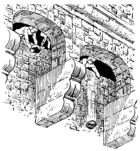Machicolation



A machicolation (from the French: mâchicoulis, Template:Lang-de, Template:Lang-it) is a floor opening between the supporting corbels of a battlement, through which stones or other material, such as boiling water or boiling cooking oil, could be dropped on attackers at the base of a defensive wall.
Description and use
The design was adopted in the Middle Ages in Europe when Norman crusaders returned from the Holy Land. A machicolated battlement projects outwards from the supporting wall in order to facilitate this. A hoarding is a similar structure made of wood, usually temporarily constructed in the event of a siege. Advantages of machicolations over wooden hoardings include the greater strength and fire resistance of stone.

The word derives from the Old French word machecol, mentioned in Medieval Latin as machecollum, probably from Old French machier[1] 'crush', 'wound' and col 'neck'. Machicolate is only recorded in the 18th century in English, but a verb machicollāre is attested in Anglo-Latin.[2] The Spanish word denoting this structure, matacán, is similarly composed from "matar canes" meaning roughly "killing dogs", the latter being a reference to infidels.[3]
Machicolations were more common in French castles than English, where they were usually restricted to the gateway, as in the 13th-century Conwy Castle.[4]
One of the first examples of machicolation that still exists in northern France is Château de Farcheville built in 1291 outside Paris.
Similar to a machicolation is a smaller version which opens as a balcony, generally from a tower rather than a larger structure. This is called a box-machicolation.[5]
Machicolations were a common feature in many towers and rural buildings in Malta until the 18th century. Buildings with machicolations include Cavalier Tower, Gauci Tower, the Captain's Tower, Birkirkara Tower and Tal-Wejter Tower.[5]
Post-medieval use
Machicolation was later used for decorative effect with spaces between the corbels but without the openings, and subsequently became a characteristic of many non-military buildings (for example, Scottish baronial architecture from the 16th century onwards, and Gothic buildings of the 19th and 20th centuries).
See also
References
- Notes
- ^ A.-J. Greimas, Dictionnaire de l’ancien français, Paris 1987 ISBN 2-03-340-302-5
- ^ Hoad (1986)
- ^ Villena (1988)
- ^ Brown (2004), p. 66.
- ^ a b Spiteri, Stephen C. (May 2008). "A Medieval tower at Qrendi?" (PDF). Arx - Online Journal of Military Architecture and Fortification (6): 59. Archived from the original (PDF) on 27 November 2016.
{{cite journal}}:|archive-date=/|archive-url=timestamp mismatch; 26 November 2016 suggested (help)
- Bibliography
- Brown, R. Allen (2004) [1954]. Allen Brown's English Castles. Woodbridge: The Boydell Press. ISBN 1-84383-069-8.
- Hoad, T. F. (1986), English Etymology, Oxford University Press
- Villena, Leonardo (1988). "Sobre las defensas verticales en España: tipología y terminlogía comparadas". In Andrés Bazzana (ed.). Guerre, fortification et habitat dans le monde méditerranéen au Moyen Age: colloque. Casa de Velázquez. ISBN 978-84-86839-02-4.
Further reading
- Mesqui, Jean (1997). Châteaux forts et fortifications en France. Paris: Flammarion. pp. 493 pp. ISBN 2-08-012271-1.
{{cite book}}: Cite has empty unknown parameter:|coauthors=(help)
